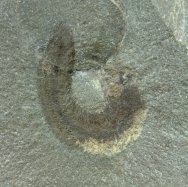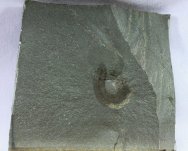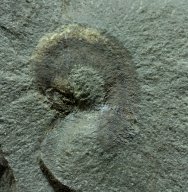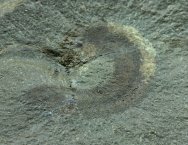Annelida
indet
Phylum Annelida, Class Polychaeta
Geological
Time: Mississippian (~320 m.y.a.)
Size (25.4
mm = 1 inch): Fossil is 43 mm long (curve measure); Matrix: 90 mm
by 95
mm
Fossil Site:
Heath Shale Formation, Bear Gulch Limestone, Fergus County, Montana
Fossil Code:
BGF646
Price: Sold
 Description:
The Bear Gulch Limestone is a deposit of some 70 square km in extent
and 30 m in depth that has been a source of one of the most diverse
assemblages of fossil fish with some 110 species having been described
over the past 30 years. Most were new to science, and provided a
unique view of the marine environment of Mississippian times. Fine
preservation of both fish and invertebrates is a hallmark of these
deposits, presumably due to an anoxic depositional environment.
This specimen is a rarely seen member of the Polychaetae, or Bristleworms.
The polychaete worms are related to earthworms and leeches, well-known
members of the Phylum Annelida. They derive their common name from
the setae (or chaetae – bristles) on each side of the body
which can be seen here in the central part of the body. The Polychaetae
can trace their fossil record back to the 520 million year old Burgess
Shale where examples such as Burgessochaeta and Canadia have been
preserved. Description:
The Bear Gulch Limestone is a deposit of some 70 square km in extent
and 30 m in depth that has been a source of one of the most diverse
assemblages of fossil fish with some 110 species having been described
over the past 30 years. Most were new to science, and provided a
unique view of the marine environment of Mississippian times. Fine
preservation of both fish and invertebrates is a hallmark of these
deposits, presumably due to an anoxic depositional environment.
This specimen is a rarely seen member of the Polychaetae, or Bristleworms.
The polychaete worms are related to earthworms and leeches, well-known
members of the Phylum Annelida. They derive their common name from
the setae (or chaetae – bristles) on each side of the body
which can be seen here in the central part of the body. The Polychaetae
can trace their fossil record back to the 520 million year old Burgess
Shale where examples such as Burgessochaeta and Canadia have been
preserved.
Also
see: Bear Gulch Fossils |
|



